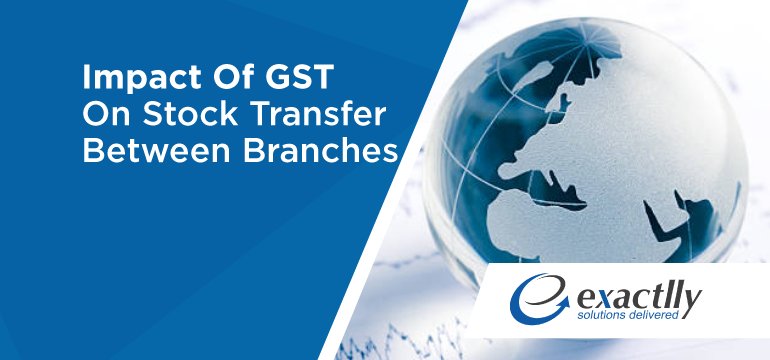Impact Of GST On Stock Transfer Between Branches

The GST is about to bring the Indian marketplace into the foray of a single unified tax system – the largest tax reform that the nation has witnessed since independence. The aim of the GST is to subsume all the existing taxes into a single tax for bringing about ease of credit flow across the nation (interstate), and across the supply chain – right from the manufacturer to the consumer. Additionally, with the advent of the GST, concepts such as manufacture, trade and service provisions become irrelevant as supply becomes the taxable event.
What does Supply mean under the Impact Of GST?
Under the GST regime, supply has been defined to include transfers. Since certain specific supplies made without consideration are taxable, this amounts to stock transfers under the impact Of GST also being taxable. Businesses are required to understand the implications that a stock transfer can have – something we have provided an overview of here.
Taxability of stock transfers:
- A registered manufacturer is required to pay 100% excise duty + 10% of the production cost under the central excise laws for making a stock transfer of excisable goods.
- A registered manufacturer is required to furnish Form F which makes stock transfers non-taxable under the VAT. It is however pertinent to note that different states have different percentages under the VAT on the basis of which the input on purchase of goods can be reversed.
Tax is levied on supply (inclusive of transfers). When coupled with the definition of a distinct person, it must be understood that a branch has the meaning of a different entity. Therefore, stock transfers become taxable in the following manner –
- Intrastate – when a business entity is registered in one state with more than one registration
- Interstate – when there occurs a transfer between two business entities in different states (which is a taxable event)
The cash flow of a business is greatly impacted under the GST due to the taxability of stock transfers as tax is paid against a stock transfer on the date of such transfer and the input tax credit is utilized only when such transfer has been liquidated by the branch receiving the transfer. Therefore, businesses should keep in mind the requirements of additional working capital that may arise due to the taxability of stock transfers, especially businesses operating in the fast-moving consumer goods and pharmaceutical sectors. SMEs may find this aspect as an obstacle if they don’t pay attention to their working capital needs.
It may also be noted that funds for seasonal businesses are blocked for long periods of time as the sales mostly take place only during a particular period in a year – additionally, the impact Of GST is paid during the month when the transfers are made from the branch however, the credit shall only be utilized during the month when the actual sale takes place.
ITC Impact:
- Reduction in rate of availability of input VAT for goods or inputs that are used for manufacturing of finished goods, which are then transferred, with the reversal rate differing from one state to the other.
- Input VAT credit is mostly available at a rate of 4% excess of the tax paid on the purchase of the goods. In case VAT is paid at 12.5 % for the purchase of a textile bundle, then an excess of 4 % amounting to 8.5% shall be permitted as input VAT credit. This 4% will further be reversed. When such input tax credit is reversed, it is added to the main product cost and leads to a cascading effect.
Let us consider the following example, under the current tax regime –
| VAT | |
| Value of purchase of 10 textile bundles | 10,000 |
| 14.5% VAT | 1,450 |
| Total Value | 11,450 |
| Stock transfer | NIL |
| Exemption from VAT | NIL |
| Eligibility in terms of Input Tax Credit | |
| 14.5% VAT | 1,450 |
| Excess of 4% Input tax credit – 10.5% (14.5% Minus 4%) | 1,050 |
| Reversal Rate at 4% | 4,00 |
| Therefore, INR 400 is added to the total product cost. | |
Under the GST regime, the input tax credit is available basis of the tax paid on the transferred stock. Assuming GST is levied at 18% –
| GST | |
| Value of purchase of 10 textile bundles | 10,000 |
| CGST 9% | 900 |
| SGST 9% | 900 |
| Total Value | 11,800 |
| Stock Transfer | NIL |
| CGST 9% | 900 |
| SGST 9% | 900 |
| Eligibility in terms of Input Tax Credit | |
| CGST 9% | 900 |
| SGST 9% | 900 |
| Therefore, INR 1,800 is available as an input tax credit. | |
The lack of requirement of declaration forms under the GST makes the processing of stock transfers a much faster process. Under the current regime (VAT), the hassle of furnishing Form F for being eligible to get an exemption on the stock transfer is cumbersome. The assessing authority needs to be notified of sending the goods to a different branch where the sale takes place on a different date.
Under the GST regime, there are no declaration forms required to be filed for stock transfers, making the process extremely smooth and doing away with extra effort and costs that dealers had to earlier incur.
Ascertaining tax basis the stock transfers:
Stock transfers are usually done when goods are moved from one branch or unit to another without involving a consideration. However, it is difficult to ascertain how much tax liability arises on such transactions. Under the central excise laws, as mentioned above, the cost is taken as follows –
- 100% – for payment of excise duty
- 10% – for the cost of production
Under the VAT laws, levy of tax is exempt on stock transfers.
Under the GST regime, the value of a transaction is based on the value of the Impact Of GST levied on the goods. Where a stock transfer is in question, the value of the transaction cannot be used to determine the tax levy as such transfer is made in the absence of consideration. The determination of tax still remains a complicated matter under the GST as the tax to be imposed is expected to be valued on the basis of goods grouped together on the basis of factors such as their qualities, likeness etc. shall enable the business to decide the cost of production and the profit on the product.
Finalizing of the GST laws and rules are awaited in order to shed light and clarity on these aspects.
The need for having units and branches:
Most businesses today have units and branches in order to feed their statutory needs and gain tax advantages. Having operations in several states enables a business to gain benefits from the local VAT, in turn allowing the buyer to avail of credit. Further, branch transfers are voluminous as stock transfers are not taxable.
Since interstate transactions under the GST allow for seamless flow of input tax credit, businesses are not required to open branches in all the states in which they operate, for statutory reasons. Branches or units under the GST are now only required if it is viable for the business in terms of its commercial operations. This helps a business to cut down costs incurred on opening branches, enables better planning and preparation, and more importantly, reduces the high volume of branch transfers.
Impact of cross branch transfer under the GST:
Businesses having branches are bound to engage in transfers across branches based on demand and availability of inventory in one branch as opposed to the other. For example, a head office branch may transfer goods to a unit based in a different state. The goods received by the unit are then transferred to another unit of the same business – this entire transaction is very costly under the GST regime. Under the GST regime, every time a transfer takes place, GST is payable, resulting in an impact on the cash flow of the branch/unit. This process is required to be avoided in order to make transfers more cost-effective and beneficial and enable transfers directly from a warehouse to a branch or unit.
Businesses can avoid working capital pressure by transferring all stock to a branch that has high demand – this will ensure that liquidation of stock happens faster.
In conclusion, stock transfers are allowed as a credit under the GST despite being fully taxable – leading to an elimination of the cascading effect of tax as under the current tax system. This will enable products to be more cost-effective at their final value. Finally, working capital pressure is expected to reduce to a great extent as branch transfers are likely to be more effective under the GST regime.
Want to know more about exactlly? Feel free to Contact Us and get a Free Demo.






